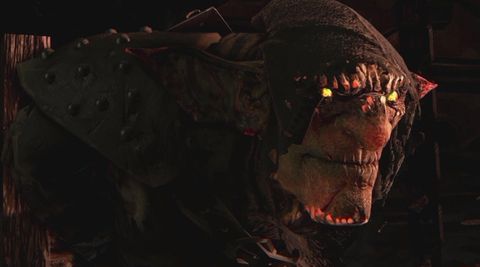Our Verdict
Admirably open levels that reward exploration means theres high replay value if youre prepared to overlook the back-tracking.
PC Gamer's got your back
What is it?
A third person stealth game with modest RPG elements set in a wonderfully vertical environment and where F5 is your friend.
Play it on: AMD/Intel dual-core 2.4 GHz, AMD Radeon HD 5850, Nvidia GEForce GTX 560 or higher
Alternatively: Dishonored, 92%
Copy protection: Steam
Expect to pay: £25/$30
Release: Out now
Developer: Cyanide Studio
Publisher: Focus Home Interactive
Multiplayer: None
Link: Official site
By Jon Morcom.
Styx: Master of Shadows announced its arrival as the follow-up and prequel to 2012’s Of Orcs and Men with little fanfare but boasting of its hardcore stealth credentials. Set in a gloomy fantasy world within the soaring Tower of Akenash, the titular Styx is a goblin who for pecuniary reasons wants to steal the heart of the mighty World Tree, the source of a magical nectar called Amber which is to the Tower’s inhabitants what Adam is to the denizens of Rapture. However, our cantankerous protagonist’s parlous mental state hints that there will be more to his journey than simply rocking up to the Antiques Roadshow with the heart for a valuation should he manage to get hold of it.
Styx can puke up a clone of himself who, for a short time, can pass through locked gates.
As you would hope from its setting, the levels in this game offer a lot of verticality and plenty of high road/low road routes through some fantastically open environments. Styx’s movement is for the most part fluid and the mouse and keyboard controls work well; however, his parkour skills are not as precisely calibrated as those found in say Assassin’s Creed games. Unless you’re scaling the game’s obvious cruciform climb points, ledge-grabbing and jumping can be a lottery with Styx destined to die a number of comical deaths.
The sneaking is satisfying and can find you switching tempo in the blink of an eye. One moment you’ll be in a good rhythm, methodically clearing an area full of guards but then you might just as easily find yourself hiding in a cupboard for some minutes, waiting to make your next move. Styx has no non-lethal takedown option, just a ‘muffled kill’ move that leaves him vulnerable for five seconds or a swift, noisy kill that immediately turns him into a guard magnet. In addition to gathering up consumables like Vials of Health, Amber (manna for your special skills) and throwing knives spread around each map, you can use Amber Vision to identify alternative routes and glyphs on the walls that point the way to secret hiding places.
Collecting tokens, rare relics and completing primary and secondary mission tasks earns you points that can be used to augment seven skill sets. But crucially this skill-buffing can only take place when you reach your hideout at the end of each chapter. The most dynamic of these abilities is Cloning. Styx can puke up a clone of himself who, for a short time, can pass through locked gates, work mechanisms, create diversions or even hide in cupboards and bump-off pesky guards for you. Invisibility is also possible for brief periods but it expends a lot of Amber and, frankly, feels like cheating.

With S:MoS’s emphasis firmly on stealth, combat is very much a last resort and its mechanics here are so perfunctory, it’s as if the developers have made it deliberately dull to push players down the less confrontational path. Taking flight is sometimes possible through repeated mashing of the roll and jump keys but more often than not you’ll be locked into a one-on-one with the guard; parry his sword blows successfully a few times with your trusty knife and you’ll get a ‘kill’ prompt so you can finish him off. But unless you’ve isolated that one guard, others will soon be upon you until you’re overwhelmed. By the middle of the game there are hundreds of guards to whack or bypass, not all of whom can be eliminated quietly so you need to make good use of all you see in the environment. Frequent quick saving is essential throughout but the balance of the game is such that even when you’re crouched under a table, staring at some guard’s groin and you’re down to your last drops of health or Amber, there is always a way out.

A stealth game will usually stand or fall by the quality of its AI and when they’re not inadvertently frotting the scenery or each other, S:MoS’s guards demonstrate admirable levels of general alertness but they are also seemingly afflicted with some debilitating form of myopia. Bump into a chair or toggle Styx out of crouch mode and his footsteps will bring a band of strangely foul-mouthed sentries rushing your way in quick time. On the other hand, the guards’ seeming lack of any peripheral vision means you can often literally get away with murder.
For all its openness, there were a few points in the game where I felt I was being funneled and perhaps the most disappointing aspect was the re-visiting and re-population of some areas, these levels being augmented with non-human enemies; the advent of the latter feels like gratuitous hurdle placement and the asset recycling in general gives the impression the game has been padded out. But those gripes aside, S:MoS weaves an entertaining Grimm-like yarn in and around twenty hours-worth of furtive fun.




Admirably open levels that reward exploration means theres high replay value if youre prepared to overlook the back-tracking.
Hey folks, beloved mascot Coconut Monkey here representing the collective PC Gamer editorial team, who worked together to write this article! PC Gamer is the global authority on PC games—starting in 1993 with the magazine, and then in 2010 with this website you're currently reading. We have writers across the US, UK and Australia, who you can read about here.

